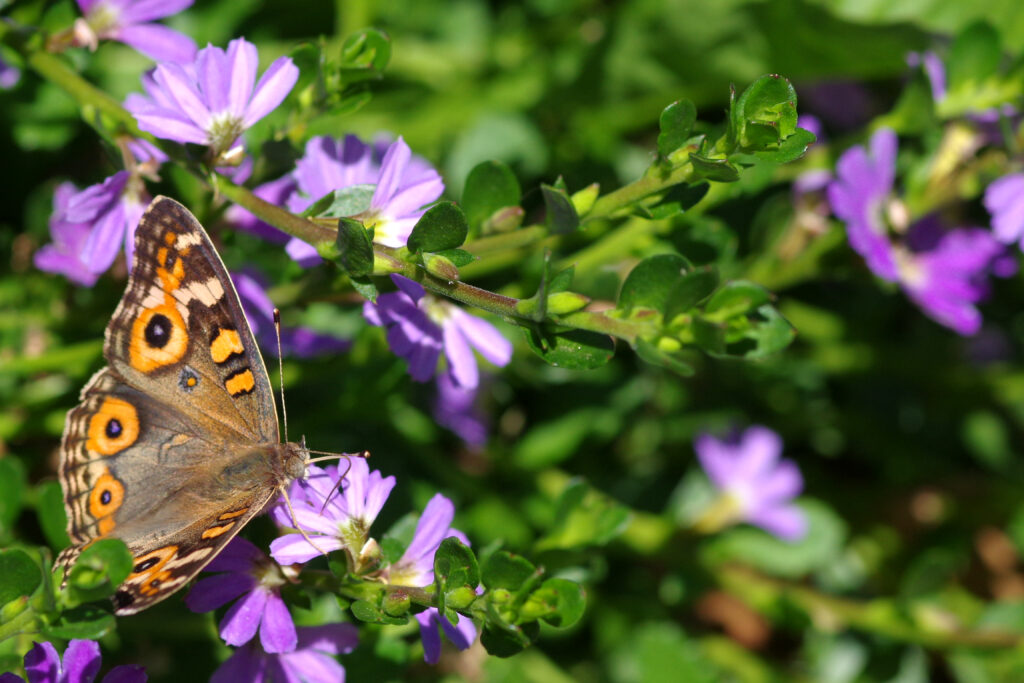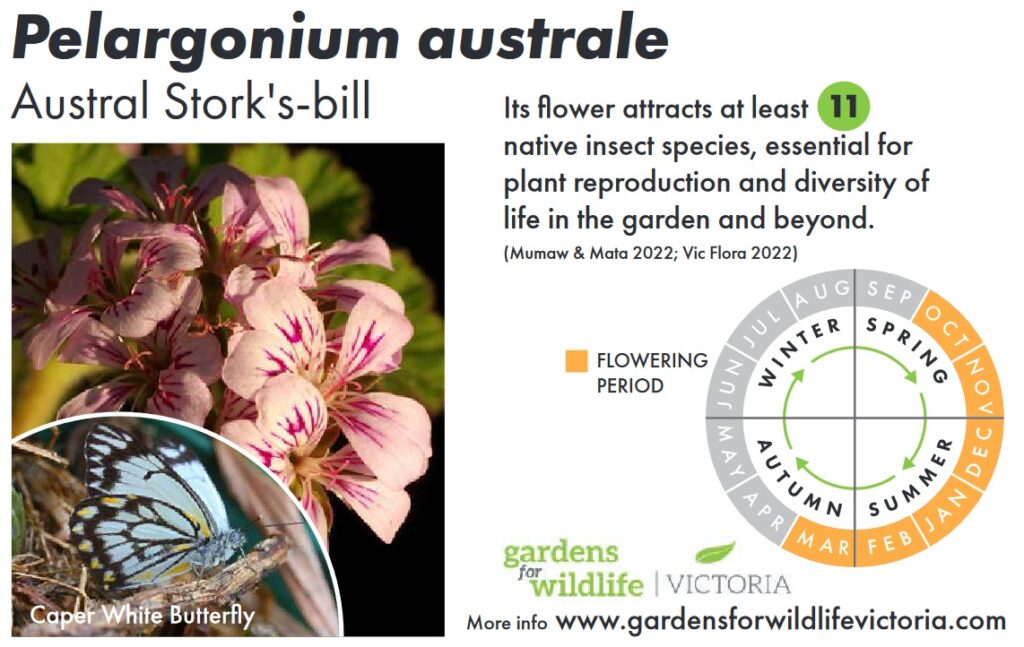SUPPORTING NATIVE PLANTS AND
THEIR INSECT POLLINATORS
Gardeners, in cities and elsewhere, can help sustain locally native plants and insects. Gardens for Wildlife Victoria commissioned research (Mumaw & Mata, 2021) to better understand how wildlife gardening can contribute to the wellbeing of wildlife gardeners, indigenous plant species, and their insect pollinators.
Here we showcase information from that work that we hope will be of use to wildlife gardeners, indigenous plant nurseries, and anyone interested in indigenous plants and insect pollinators. The research included surveys across a calendar year of indigenous plant species provided by four indigenous plant nurseries supplying wildlife gardening programs in greater Melbourne. Many of these species are found across Victoria.

If you are interested in including these plants in your garden, many of these will be available at your local indigenous nursery. A list of indigenous plant nurseries that supply some Gardens for Wildlife programs in Victoria can be found below:
Indigenous Plant Nurseries
Insect pollinators found on indigenous plants in the research
The research tracked insects found on the reproductive organs of flowers of 37 indigenous plant species across a year. Most of the observed insects are recognised as pollinators. Native insect species (36) were more frequently seen than introduced species (7). Most of the plant species were seen with both indigenous and introduced insect pollinators, but a few were associated with only one or the other group. The European honeybee was the most frequently observed species, followed by native sweat bees and hoverflies. Native sweat bees and grass blue butterflies were found across the greatest diversity of studied plant species (seeMumaw & Mata, 2021, pp 42-48 for details)
To see an illustration of the number of native insect species found on each of the studied plant species, please click on the plant name in the Table Below. This will display a photo of a plant and one of the insect species, and a graphic of its flowering period.
TABLE A:
High Performing Indigenous plants for attracting native insect pollinators
Austral stork’s-bill
Common everlasting
Cut-leaf daisy
Hop goodenia
Sticky everlasting
Twiggy daisy-bush
Yarra burgan







TABLE B:
All indigenous plants included in this study – With links to plant labels:
Indigenous plant labels
Gardens for Wildlife Victoria have designed 35 indigenous plant labels based on observations from the research commissioned from Mumaw & Mata (2021).
The Plant labels can be downloaded at the links and printed in a format and size commonly used by many indigenous nurseries. The labels include marks for cutting.
| Scientific Name: | Common Name: | Pollinators Attracted: | Printable Plant Label: |
| Banksia marginata | Silver banksia | 2 | Banksia marginata |
| Brachyscome multifida | Cut-leaf daisy | 13 | Brachyscome multifida |
| Brachyscome paludicola | Swamp daisy | 5 | Brachyscome paludicola |
| Brunonia australis | Blue pincushion | 2 | Brunonia australis |
| Bulbine bulbosa | Bulbine lily | 3 | Bulbine bulbosa |
| Bursaria spinosa | Kurwan | 3 | Bursaria spinosa |
| Cassinia sp. | Cassinias | 7 | Cassinia sp. |
| Chrysocephalum apiculatum | Common everlasting | 10 | Chrysocephalum apiculatum |
| Chrysocephalum semipapposum | Clustered everlasting | 9 | Chrysocephalum semipapposum |
| Clematis microphylla | Small leaved-clematis | 2 | Clematis microphylla |
| Coronidium scorpioides | Button everlasting | 3 | Coronidium scorpioides |
| Correa alba | White correa | 6 | Correa alba |
| Correa glabra | Rock correa | 3 | Correa glabra |
| Correa reflexa | Common correa | 2 | Correa reflexa |
| Dianella sp. | Flax-lilies | 4 | Dianella sp. |
| Epacris impressa | Common heath | 3 | Epacris impressa |
| Geranium sp. | Crane’s-bills | 3 | Geranium sp. |
| Glycine clandestina | Twining glycine | 2 | Glycine clandestina |
| Goodenia ovata | Hop goodenia | 10 | Goodenia ovata |
| Goodenia paradoxa | Spur goodenia | 1 | Goodenia paradoxa |
| Hakea nodosa | Yellow hakea | 2 | Hakea nodosa |
| Kunzea leptospermoides | Yarra burgan | 11 | Kunzea.sp |
| Leptospermum sp. | Teatrees | 6 | Leptospermum sp. |
| Leucochrysum albicans | Hoary sunray | 2 | Leucochrysum albicans |
| Linum marginale | Native flax | 1 | Linum marginale |
| Lythrum salicaria | Purple loosestrife | 1 | Lythrum salicaria |
| Microseris sp. | Murnongs | 5 | Microseris sp. |
| Olearia myrsinoides | Silky daisy-bush | 2 | Olearia myrsinoides |
| Olearia ramulosa | Twiggy daisy-bush | 9 | Olearia ramulosa |
| Pelargonium australe | Austral stork’s-bill | 11 | Pelargonium australe |
| Podolepis jaceoides | Showy podolepis | 4 | Podolepis jaceoides |
| Scaevola aemula | Fairy fan-flower | 2 | Scaevola aemula |
| Viola hederacea | Ivy-leaved violet | 1 | Viola hederacea |
| Wahlenbergia sp. | Bluebells | 4 | Wahlenbergia sp. |
| Xerochrysum viscosum | Sticky everlasting | 19 | Xerochrysum viscosum |
